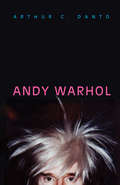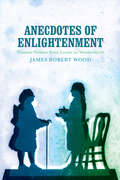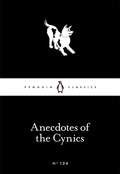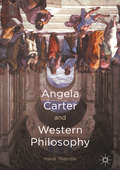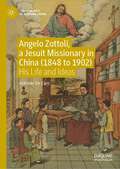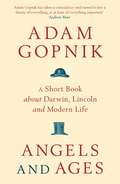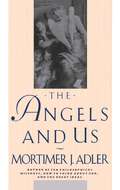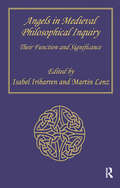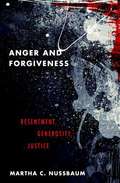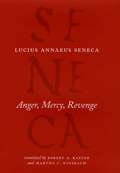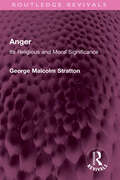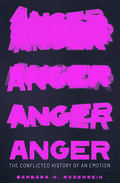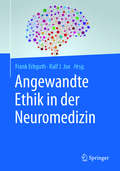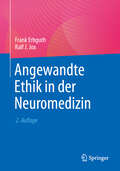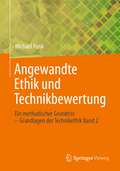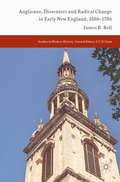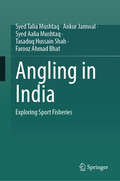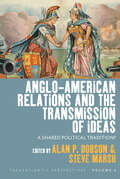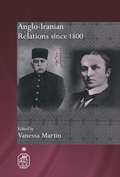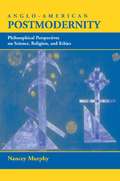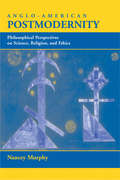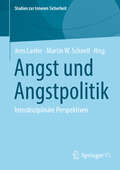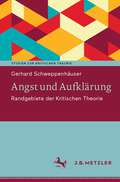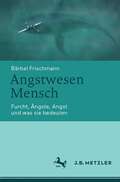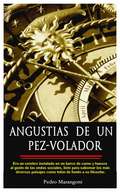- Table View
- List View
Andy Warhol: 21 Segi Changjojeok Injaeeui Rolmodel = [andy Warhol] (Icons of America #12)
by Arthur C. Danto&“Astutely traces the ripple effects of Warhol&’s blurring of the lines between commercial and fine art, and art and real life…masterful.&”—Booklist (starred review) Art critic, philosopher, and winner of a National Book Critics Circle Award Arthur Danto delivers a compact, masterful tour of Andy Warhol&’s personal, artistic, and philosophical transformations. Danto traces the evolution of the pop artist, including his early reception, relationships with artists such as Jasper Johns and Robert Rauschenberg, and the Factory phenomenon. He offers close readings of individual Warhol works, including their social context and philosophical dimensions, key differences with predecessors such as Marcel Duchamp, and parallels with successors like Jeff Koons. By drawing on subject matter understandable to the ordinary American, Warhol revolutionized the way we look at art. In this book, Danto brings to bear encyclopedic knowledge of Warhol&’s time and shows us Warhol as an endlessly multidimensional figure—artist, political activist, filmmaker, writer, philosopher—who retains permanent residence in our national imagination.
Anecdotes of Enlightenment: Human Nature from Locke to Wordsworth
by James Robert WoodAnecdotes of Enlightenment is the first literary history of the anecdote in English. In this wide-ranging account, James Robert Wood explores the animating effects anecdotes had on intellectual and literary cultures over the long eighteenth century. Drawing on extensive archival research and emphasizing the anecdote as a way of thinking, he shows that an intimate relationship developed between the anecdote and the Enlightenment concept of human nature. Anecdotes drew attention to odd phenomena on the peripheries of human life and human history. Enlightenment writers developed new and often contentious ideas of human nature through their efforts to explain these anomalies. They challenged each other’s ideas by reinterpreting each other’s anecdotes and by telling new anecdotes in turn.Anecdotes of Enlightenment features careful readings of the philosophy of John Locke and David Hume; the periodical essays of Joseph Addison, Richard Steele, and Eliza Haywood; the travel narratives of Joseph Banks, James Cook, and James Boswell; the poetry of Samuel Taylor Coleridge and William Wordsworth; and Laurence Sterne’s Tristram Shandy. Written in an engaging style and spotlighting the eccentric aspects of Enlightenment thought, this fascinating book will appeal to historians, philosophers, and literary critics interested in the intellectual culture of the long eighteenth century.
Anecdotes of the Cynics (Penguin Little Black Classics)
by Robert Dobbin'It's you who are the dogs...'
Angela Carter and Western Philosophy
by Heidi YeandleThis book unearths Carter's deconstruction of the male-dominated discipline of Western thought. Revealing the extensive philosophical research that underpins Carter's intertextual work, this book offers new readings of her fiction in relation to a range of philosophical texts and ideas. By re-examining Carter's writing with reference to the archived collection of her notes that has recently become available at the British Library, Angela Carter and Western Philosophy puts forward new interpretations of Carter's writing practices. With chapters examining her allusions to Plato, Hobbes and Rousseau, Descartes, Locke and Hume, Wittgenstein and Ryle, as well as Kant and Sade, this book illuminates Carter's engagement with different areas of Western thought, and discusses how this shapes her portrayal of reality, identity, civilisation, and morality. Angela Carter and Western Philosophy will be of interest to researchers, lecturers, and students working on contemporary women's writing, philosophy and literature, and intertextual literary practices.
Angelo Zottoli, a Jesuit Missionary in China: His Life and Ideas (Christianity in Modern China)
by Antonio De CaroThis book offers a study of the cosmogonic works by Fr. Angelo Zottoli S.J., a Jesuit missionary who has received relatively little attention by modern scholars, but who deserves a special recognition for his theological and philosophical ideas. More generally, the book aims to shed light on the importance of cosmogony in the cross-cultural and interdisciplinary environment of Xujiahui, the area in modern Shanghai where Zottoli flourished. It shows how through Zottoli’s teaching and sermons he was able to reimagine his own cosmogonic ideas, his personality, and his relationship with local Chinese converts. Among Zottoli’s most famous students was Ma Xiangbo (馬相伯 1840–1939) and Zottoli played a crucial role in Ma’s intellectual formation.A wider familiarity with Zottoli’s works is not only interesting in and of itself, but also paves the way to future studies on the complex and multifaceted relationship between European missionaries and Chinese students in Shanghai during the nineteenth century.
Angels and Ages: A short book about Darwin, Lincoln and modern life
by Adam Gopnik'Adam Gopnik has taken a coincidence and turned it into a theory of everything, or at least of everything important ... Outstanding' - Andrew MarrOn February 12th, 1809, two men were born an ocean apart: Abraham Lincoln in a one-room Kentucky log cabin; Charles Darwin on an English country estate. Each would see his life's work transform mankind's understanding of itself. In this bicentennial twin portrait, Adam Gopnik shows how these two giants, who never met, changed the way we think about the very nature of existence, and that their great achievements proceeded from the same source: argument from reason. The revolutions they effected shaped the world we live in, while the intellectual heritage and method that informed their parallel lives has profound implications for our present age. Filled with little-known stories and unfamiliar characters, Angels and Ages reveals these men in a new, shared light, and provides a fascinating insight into the origins of our modern vision and liberal values.
Angels and Us
by Mortimer J. AdlerA wonderfully enlightening work on the affinities between angels and human beings.Mortimer Adler has always been ahead of his time. In 1982, before the current revival of interest in angels, Dr. Adler published "The Angels and Us," an engaging look at the various images and hierarchies of angels (including guardian angels). Dr. Adler, the bestselling author of "Ten Philosophical Mistakes," "Aristotle for Everybody," and "The Great Ideas," speculates on the existence of angels; why Jews, Christians, and Muslims believe in angels, and the ways angels have been viewed as objects of religious belief and philosophical thought. This is a wonderfully enlightening work on the affinities between angels and human beings.
Angels in Medieval Philosophical Inquiry: Their Function and Significance (Ashgate Studies In Medieval Philosophy Ser.)
by Martin LenzThe nature and properties of angels occupied a prominent place in medieval philosophical inquiry. Creatures of two worlds, angels provided ideal ground for exploring the nature of God and his creation, being perceived as 'models' according to which a whole range of questions were defined, from cosmological order, movement and place, to individuation, cognition, volition, and modes of language. This collection of essays is a significant scholarly contribution to angelology, centred on the function and significance of angels in medieval speculation and its history. The unifying theme is that of the role of angels in philosophical inquiry, where each contribution represents a case study in which the angelic model is seen to motivate developments in specific areas and periods of medieval philosophical thought.
Anger and Forgiveness: Resentment, Generosity, and Justice
by Martha C. NussbaumAnger is not just ubiquitous, it is also popular. Many people think it is impossible to care sufficiently for justice without anger at injustice. Many believe that it is impossible for individuals to vindicate their own self-respect or to move beyond an injury without anger. To not feel anger in those cases would be considered suspect. Is this how we should think about anger, or is anger above all a disease, deforming both the personal and the political? <p><p> In this wide-ranging book, Martha C. Nussbaum, one of our leading public intellectuals, argues that anger is conceptually confused and normatively pernicious. It assumes that the suffering of the wrongdoer restores the thing that was damaged, and it betrays an all-too-lively interest in relative status and humiliation. Studying anger in intimate relationships, casual daily interactions, the workplace, the criminal justice system, and movements for social transformation, Nussbaum shows that anger's core ideas are both infantile and harmful. <p> Is forgiveness the best way of transcending anger? Nussbaum examines different conceptions of this much-sentimentalized notion, both in the Jewish and Christian traditions and in secular morality. Some forms of forgiveness are ethically promising, she claims, but others are subtle allies of retribution: those that exact a performance of contrition and abasement as a condition of waiving angry feelings. In general, she argues, a spirit of generosity (combined, in some cases, with a reliance on impartial welfare-oriented legal institutions) is the best way to respond to injury. Applied to the personal and the political realms, Nussbaum's profoundly insightful and erudite view of anger and forgiveness puts both in a startling new light.
Anger, Mercy, Revenge (Complete Works Of Lucius Annaeus Seneca Ser.)
by Lucius Annaeus SenecaLucius Annaeus Seneca (4 BCE–65 CE) was a Roman Stoic philosopher, dramatist, statesman, and adviser to the emperor Nero, all during the Silver Age of Latin literature. The Complete Works of Lucius Annaeus Seneca is a fresh and compelling series of new English-language translations of his works in eight accessible volumes. Edited by world-renowned classicists Elizabeth Asmis, Shadi Bartsch, and Martha C. Nussbaum, this engaging collection restores Seneca—whose works have been highly praised by modern authors from Desiderius Erasmus to Ralph Waldo Emerson—to his rightful place among the classical writers most widely studied in the humanities.Anger, Mercy, Revenge comprises three key writings: the moral essays On Anger and On Clemency—which were penned as advice for the then young emperor, Nero—and the Apocolocyntosis, a brilliant satire lampooning the end of the reign of Claudius. Friend and tutor, as well as philosopher, Seneca welcomed the age of Nero in tones alternately serious, poetic, and comic—making Anger, Mercy, Revenge a work just as complicated, astute, and ambitious as its author.
Anger: Its Religious and Moral Significance (Routledge Revivals)
by George Malcolm StrattonFirst published in 1923, Anger presents some considerations of anger where it comes close to conduct and religion. It is hoped that the explanation of conscience, and of the origins of religion, and particularly of monotheism has been carried a firm step farther than hitherto, and that interest will be found in the novel grouping of the great faiths with respect to wrath. The spirit of the great religions is drawn from their sacred writings. This book will be of interest to students of philosophy and religion.
Anger: The Conflicted History of an Emotion (Vices and Virtues)
by Barbara H. RosenweinTracing the story of anger from the Buddha to Twitter, Rosenwein provides a much-needed account of our changing and contradictory understandings of this emotion All of us think we know when we are angry, and we are sure we can recognize anger in others as well. But this is only superficially true. We see anger through lenses colored by what we know, experience, and learn. Barbara H. Rosenwein traces our many conflicting ideas about and expressions of anger, taking the story from the Buddha to our own time, from anger&’s complete rejection to its warm reception. Rosenwein explores how anger has been characterized by gender and race, why it has been tied to violence and how that is often a false connection, how it has figured among the seven deadly sins and yet is considered a virtue, and how its interpretation, once largely the preserve of philosophers and theologians, has been gradually handed over to scientists—with very mixed results. Rosenwein shows that the history of anger can help us grapple with it today.
Angewandte Ethik in der Neuromedizin
by Ralf J. Jox Frank ErbguthDas Praxisbuch zeigt anhand verschiedener klinischer Situationen in der Neuromedizin, wie die wissenschaftliche Reflexion auf dem Gebiet der Neuroethik praktisch angewendet werden kann. Es richtet sich prim#65533;r an #65533;rzte sowie alle anderen Gesundheitsberufe, die in Neurologie, Neurochirurgie oder Neuroradiologie mit ethischen Fragen konfrontiert sind, die sich speziell in ihrem T#65533;tigkeitsbereich ergeben. Indem es den klinischen Kontext in den Blick r#65533;ckt, schlie#65533;t das Werk die L#65533;cke zwischen Einf#65533;hrungsb#65533;chern und wissenschaftlichen Handb#65533;chern zur Neuroethik. Der Themenkanon umspannt die wesentlichen relevanten Felder der Neuroethik von der klinischen Ethikberatung bis zu einzelnen ethischen Fragen in der Neurodiagnostik, bei Neurointerventionen und in speziellen neuroklinischen Situationen. Herausgegeben von einem wissenschaftlich t#65533;tiger Ethiker und Neurologen und einem Krankenhausneurologen, wirken an dem Buch Experten aus verschiedenen Disziplinen und L#65533;ndern mit.
Angewandte Ethik in der Neuromedizin
by Ralf J. Jox Frank ErbguthAnhand ausgewählter klinischer Situationen in der Neuromedizin zeigt dieses Buch, wie die wissenschaftliche Reflexion auf dem Gebiet der Neuroethik praktisch angewendet werden kann. Es richtet sich primär an Ärztinnen und Ärzte sowie an alle anderen Gesundheitsberufe, die in den Bereichen der Neuromedizin mit ethischen Fragen konfrontiert sind, die sich speziell in ihrem Tätigkeitsbereich ergeben. Indem es den klinischen Kontext in den Blick rückt, schließt das Werk die Lücke zwischen Einführungsbüchern und wissenschaftlichen Handbüchern zur Neuroethik. Das breite Themenspektrum wurde für die vollständig aktualisierte 2. Auflage um ein Kapitel zum gegenwärtigen Einsatz von Künstlicher Intelligenz in der Neuromedizin erweitert. Herausgegeben von einem Krankenhausneurologen und einem wissenschaftlich tätigen Neuroethiker, enthält das Buch Beiträge von Expertinnen und Experten aus verschiedenen Disziplinen und Ländern.
Angewandte Ethik und Technikbewertung: Ein methodischer Grundriss – Grundlagen der Technikethik Band 2
by Michael FunkWie bilde ich mir ein ethisches Urteil, um Konflikten zu begegnen? Was ist Technik und wer ist verantwortlich, wenn sie versagt? Stehen Menschen noch im Mittelpunkt – obwohl oder gerade weil Maschinen immer „smarter“ werden? Fragen wie diese verlangen nach einer übersichtlichen und verständlichen Präsentation ethischer Methoden der Technikbewertung. Dabei rückt vorliegendes Buch die Auseinandersetzung mit den Folgen, Risiken und Nebeneffekten technischen Handelns in den Mittelpunkt. Diese reichen von ökologischen Fragen der Entsorgung über Zweckentfremdung bis hin zur individuellen und kollektiven Verantwortung von Ingenieur*innen. Aufbauend auf Grundlagen der angewandten Ethik wird in Bottom-up- und Top-down-Verfahren die Kasuistik sowie analogisch-vergleichende und logisch-ableitende Urteilsbildung eingeführt. Wesentliche Charakteristika technischen Handelns sowie Akteursrollen werden systematisch vorgestellt. Abbildungen, Beispiele und Aufgaben runden den verständlichen Aufbau ab. Als methodischer Grundriss richtet sich vorliegendes Buch an Ingenieurwissenschaftler*innen, Informatiker*innen und Geisteswissenschaftler*innen im Berufsalltag, aber auch an interessierte Lai*innen, die mehr über ethische Praxis erfahren wollen. Es bildet den zweiten, in sich abgerundeten Teil der Buchreihe Grundlagen der Technikethik.Haben wir die Technik, die wir brauchen, und brauchen wir die Technik, die wir haben?
Anglicans, Dissenters and Radical Change in Early New England, 1686–1786 (Studies in Modern History)
by James B. BellThis book considers three defining movements driven from London and within the region that describe the experience of the Church of England in New England between 1686 and 1786. It explores the radical imperial political and religious change that occurred in Puritan New England following the late seventeenth-century introduction of a new charter for the Massachusetts Bay Colony, the Anglican Church in Boston and the public declaration of several Yale 'apostates' at the 1722 college commencement exercises. These events transformed the religious circumstances of New England and fuelled new attention and interest in London for the national church in early America. The political leadership, controversial ideas and forces in London and Boston during the run-up to and in the course of the War for Independence, was witnessed by and affected the Church of England in New England. The book appeals to students and researchers of English History, British Imperial History, Early American History and Religious History.
Angling in India: Exploring Sport Fisheries
by Ankur Jamwal Syed Talia Mushtaq Syed Aalia Mushtaq Tasaduq Hussain Shah Farooz Ahmad BhatThis book discusses the diverse array of aquatic life of Indian waters, including rivers, lakes, and coastal regions. This book is a useful manual as it explores the historical and cultural background of fishing in the country. It highlights the need of ethical fishing methods and the crucial part fishermen play in protecting the aquatic habitats. This book also covers lesser-known fishing locations and thus promotes a conservation and sustainable tourism mindset. It promotes environmental awareness and care with a focus on highlighting Indian biodiversity. Further, it offers vital details on licenses, rules, and equipment used in angling. Emphasis has been given on responsible angling and the role of anglers in aquatic biodiversity conservation efforts. This book acts as an instruction manual for anyone wishing to discover, comprehend, and safeguard the country's unique sport fisheries. It is also relevant to environmentalists and conservation advocates. Scholars and researchers in the fields of ecology, environmental science, and cultural studies will also benefit from this book for academic purposes and for understanding the cultural and ecological dimensions of angling in India.
Anglo-American Relations and the Transmission of Ideas: A Shared Political Tradition? (Transatlantic Perspectives #6)
by Steve Marsh Alan P. DobsonToo often, scholarship on Anglo-American political relations has focused on mutual social and economic interests between Britain and the United States as the basis for cooperation. Breaking new ground, Anglo-American Relations and the Transmission of Ideas instead explores how ideas, on either side of the Atlantic have mutually influenced each other. In those transnational interactions, there forms a shared tradition of political ideas, facilitating “a common cast of mind” that has served as the basis for transatlantic relations and socio-political values for decades.
Anglo-Iranian Relations since 1800 (Royal Asiatic Society Books)
by Vanessa MartinWith contributions from renowned experts in the field, this book provides an excellent background to the history of Anglo-Iranian relations. Focusing on the political and economic relationship of Britain and issues of strategic sensitivity, the book also illuminates British relations with society and the state and describes the interaction between various representatives and agents of both countries. Anglo-Iranian relations have had a long and complex history, characterized on the one hand by mistrust and intrusion and on the other by mutual exchange and understanding. This book explores the intriguing history of this interactive relationship since 1800, looking at it from a variety of perspectives. Drawing on previously unavailable documents in English and Persian, the book argues that Iran in the nineteenth century had a national state, which strongly defended the national interests.
Anglo-american Postmodernity
by Nancey MurphyThe term postmodern is generally used to refer to current work in philosophy, literary criticism, and feminist thought inspired by Continental thinkers such as Friedrich Nietzsche and Jacques Derrida. In this book, Nancey Murphy appropriates the term to describe emerging patterns in Anglo-American thought and to indicate their radical break from the thought patterns of Enlightened modernity. The book examines the shift from modern to postmodern in three areas: epistemology, philosophy of language, and metaphysics. Murphy contends that whole clusters of terms in each of these disciplines have taken on new uses in the past fifty years and that these changes have radical consequences for all areas of academia, especially in philosophy of science, philosophy of religion, and ethics.
Anglo-american Postmodernity: Philosophical Perspectives On Science, Religion, And Ethics
by Nancey MurphyThe term postmodern is generally used to refer to current work in philosophy, literary criticism, and feminist thought inspired by Continental thinkers such as Friedrich Nietzsche and Jacques Derrida. In this book, Nancey Murphy appropriates the term to describe emerging patterns in Anglo-American thought and to indicate their radical break from the thought patterns of Enlightened modernity.The book examines the shift from modern to postmodern in three areas: epistemology, philosophy of language, and metaphysics. Murphy contends that whole clusters of terms in each of these disciplines have taken on new uses in the past fifty years and that these changes have radical consequences for all areas of academia, especially in philosophy of science, philosophy of religion, and ethics. }The term postmodern is generally used to refer to current work in philosophy, literary criticism, and feminist thought inspired by Continental thinkers such as Friedrich Nietzsche and Jacques Derrida. In this book, Nancey Murphy appropriates the term to describe emerging patterns in Anglo-American thought and to indicate their radical break from the thought patterns of Enlightened modernity.The book examines the shift from modern to postmodern in three areas: epistemology, philosophy of language, and metaphysics. Murphy contends that whole clusters of terms in each of these disciplines have taken on new uses in the past fifty years and that these changes have radical consequences for all areas of academia, especially in philosophy of science, philosophy of religion, and ethics. }
Angst und Angstpolitik: Interdisziplinäre Perspektiven (Studien zur Inneren Sicherheit)
by Jens Lanfer Martin W. SchnellDieses Buch untersucht das Phänomen der gesellschaftlichen Angst und die hierauf ausgerichtete Angstpolitik. Die Angst in der Gesellschaft wird von vielen sozialwissenschaftlichen Untersuchungen angeführt, bleibt aber theoretisch und vor allem analytisch auffällig unbestimmt. Dies gilt ebenso für gesellschaftliche Diskurse: Ob nun alltägliche Unsicherheiten oder die Furcht, Sorge oder Angst gemeint sind, bleibt entweder unklar oder die Begriffe werden synonym verwendet. Das Buch setzt sich deshalb zum Ziel, verschiedene Formen der Unsicherheit in der Gesellschaft deutlicher zu bezeichnen, um soziale und politische Bedingungen und Folgen von Angst genauer fassen zu können. Die Beiträge der Autor*innen reflektieren aus unterschiedlichen Disziplinen (Geschichtswissenschaft, Philosophie, Politikwissenschaft, Soziologie) und über verschiedene Anwendungsgebiete der Sicherheitspolitik das Angstphänomen. Das Buch richtet sich an Forscher*innen, die das Phänomen der gesellschaftlichen Angst theoretisch, analytisch und empirisch untersuchen möchten.
Angst und Aufklärung: Randgebiete der Kritischen Theorie (Studien zur Kritischen Theorie)
by Gerhard SchweppenhäuserÄngste sind Teil einer krisenhaften Lebenswelt. Die Texte des Bandes gehen von einer Beobachtung der Dialektik der Aufklärung aus: Diese sieht die Intention der Aufklärung darin, „von den Menschen die Furcht zu nehmen und sie als Herren einzusetzen“, doch die „vollends aufgeklärte Erde“ erscheine „im Zeichen triumphalen Unheils“. In den vorliegenden Aufsätzen geht es darum, wie konkrete Furcht unter Bedingungen sozialer Herrschaft in diffuse Ängste diffundiert. Die Texte analysieren und kommentieren gesellschaftliche Phänomene, wie sie sich im Medium philosophischer, literarischer und bildkünstlerischer Bearbeitung darstellen. Thematisiert werden auch sozialphilosophische und -wissenschaftliche Modelle der Beschreibung sowie die Analyse und Kritik soziokultureller Phänomene. Alle Texte sind verbunden durch eine ideologiekritische Perspektive auf die Widersprüchlichkeit von Aufklärung – und durch die Erinnerung an Grundpositionen des kritischen Materialismus. Gerhard Schweppenhäuser zählt zu den führenden Kennern und Kommentatoren der Kritischen Theorie und ist Gründungs- und Mitherausgeber der Zeitschrift für kritische Theorie.
Angstwesen Mensch: Furcht, Ängste, Angst und was sie bedeuten
by Bärbel FrischmannAngst begleitet uns überallhin und jederzeit. Sie gehört zum Menschen. Der Mensch ist ein Angstwesen, und dies prägt sein Verhältnis zur Welt, zu anderen und zu sich selbst. Um die Bedeutung der verschiedenen Ängstigungsweisen zu erläutern, wird eine Unterscheidung von drei Grundfunktionen, affektive Furcht, gefühlte Ängste und geistige Angst, vorgeschlagen. Sie stellen jeweils spezifische Ausprägungen der überlebenswichtigen Gefahrenbewältigung dar, die beim Menschen nicht nur die körperliche Schutzfunktion umfasst, sondern auch durch gedankliche Antizipation möglicher Risiken und Bedrohungen geprägt ist. Aber vor allem die Angstgefühle können aus dem Gleichgewicht geraten, als leidvoll erlebt werden und sogar pathologisch werden. Deshalb soll am Ende auch die Hoffnung formuliert werden, dass Menschen die geistige Kraft besitzen, ihre Ängste sinnvoll in ihr Leben einzuordnen. Für eine differenzierte Sicht auf die Thematik werden zum einen einschlägige Theorien von Biologie über Psychologie bis Soziologie und Philosophie herangezogen, zum anderen die gewonnenen Ergebnisse mit Blick auf gesellschaftliche, politische und ideologisch-weltanschauliche Anwendungsbereiche vertieft.
Angustias de un pez-volador
by Pedro MarangoniEl más patético de los animales, el Hombre-pez-volador, en este salto de un segundo de consciencia transitoria colecciona todo lo que puede acopiar, plumas al viento, granos de polvo, alguna hoja que quizás esté flotando en la superficie. Se tropieza con el pez que salta al lado, toma la iniciativa. Y después se disuelve en el agua con algunas salpicaduras que rápidamente desaparecen. Si en el micro momento antes de tocar con la cabeza el océano de la Nada, preguntáramos el color del maravilloso cielo que acababa de recorrer, no sabría la respuesta... ... Transitoriedad es la palabra que mejor definía a Arturo, porque así se sentía: un ser pasando de una forma a otra. Viajando como un pez-volador que había nacido cuando comenzaba a salir del agua para su salto y que, momentos después, caería nuevamente en la inconsciencia cuando volviera a tocar la superficie límpida, tranquila, indiferente de un mar infinito llamado Universo. Sabía que en esta reentrada por más que se agitara, sólo provocaría algunas salpicaduras que pronto desaparecerían.
